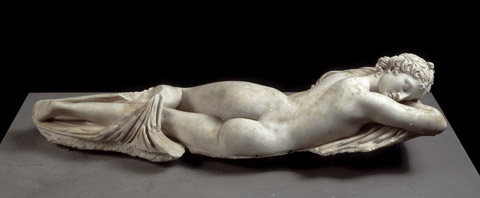
SLEEPING HERMAPHRODITE Aphrodite’s child by Hermes presents an alternative to the usual romantic narrative about the goddess. |
The ancient Greeks said the Titan Kronos cut off the penis of his father, Ouranos, the sky, and chucked it into the sea. There the frothy mix of sperm and blood spawned Aphrodite ("aphros" for "foam"), the first-born of the Olympian gods. When she first set foot on land, on the island of Cyprus, grass sprang up beneath her feet.From such happy beginnings, we get "Aphrodite and the Gods of Love" at the Museum of Fine Arts (465 Huntington Avenue, Boston, through February 20), a primer on the deity of fucking, fertility (babies, crops), and fighting that curator Christine Kondoleon assembles from 156 mostly modest-sized sculptures, coins, and striking red-and-black ceramics. All but 13 come from the MFA's world-class collection of classical Greek and Roman art.
Aphrodite, who was in fact probably spawned from Near East religions, didn't just kill them with kindness. A larger-than-life, fifth century B.C. limestone head from Cyprus is thought to depict a stout Aphrodite with long curls under a massive crown. She faces straight ahead, with a curious smile, not friendly exactly, more like the grin of a regal figure amused by how casually she can wield deadly force. A seven-foot-tall second century A.D. Roman marble "Venus Victorious" is more curvy and sensual in just a skirt and tiara, but she stands on a helmet and is probably writing the names of victorious soldiers on a now-lost shield.
Not to say that the romantic Aphrodite isn't part of the story. Tiny, sexy stone and ceramic goddesses step in and out of baths. On perfume bottles, mirrors, and vases, Aphrodite is an ideal of womanly beauty or patron of marriage. But even as the familiar pinup goddess seduces us, we tend to underestimate her cult's raw carnality. A ceramic cup shows an adolescent, winged Eros — either Aphrodite's son or a member of her entourage, depending on the tale — locked in an ecstatic groin-to-groin embrace with another gentleman. The curvy hips of the sleeping marble Hermaphrodite, Aphrodite's child by Hermes, at first suggest a life-sized nude lady kicking off a cloak, but the other side reveals breasts and a penis. The fertility god Priapus, Aphrodite's son by Dionysus, appears in one statue with an erection and in the back of a fragmented marble relief as a bust watching a woman riding atop Herakles.
Aphrodite doesn't fit easily into contemporary roles. Kondoleon compares her to Marilyn Monroe. More apt would be a mutant combo of Sarah Palin and Angelina Jolie — mama grizzly, MILF, starlet, and Hollywood action hero.
"A Day at Pompeii" at the Museum of Science (1 Science Park, Boston, through February 12), offers a snapshot of the Roman city frozen at the moment Mount Vesuvius buried it under lava and ash in the year 79. Some 250 artifacts offer many handsome finds — a large garden fresco, a bronze table, cooking ware, loaded dice, a gladiator's helmet, household goods. But the main attraction is the faces of death.
>> SLIDESHOW: "A Day in Pompeii" at the Museum of Science <<